An Evaluation of the Commonwealth Games 2014 Legacy for Scotland Report 1: Questions, Methods and Baseline
This report sets out the broad approach to the Glasgow 2014 legacy evaluation,the research questions it will address, and the range of methods that will be deployed between now and 2019. It also sets out the priorities for the next 18 months and a forward timetable for publication of reports.The report also has a series of Annexes on the 4 national themes (flourishing, active, connected and sustainable).
Annex 2: Active
Introduction
The 2014 Commonwealth Games present an opportunity to inspire Scots both young and old to become - and stay - physically active. There is good evidence that meeting physical activity recommendations can protect against many of Scotland's leading chronic diseases, and promote positive mental health and wellbeing. The recent Lancet series reported that 9% of premature mortality worldwide can be attributed to physical inactivity.39 In Scotland the Games provide an opportunity for increased mobilisation of resources, to deliver the physical activity and sports agenda.
Previous Research
Previous research on major sporting events has not evidenced a physical activity, or sports participation legacy as a result of hosting or at least not one that has been robustly tested.40 Overall, the evidence that exists provides a very mixed picture. Importantly, no Games prior to the London 2012 Olympics appear to have employed strategies that should explicitly, and potentially, raise physical activity or sport participation41. Although other events have made claims over sport participation - e.g. Sydney 2000 and Beijing 2008's aspiration to increase levels from 34.9% to 40%.
The evidence does, however, give a steer on how a physical activity legacy might be achieved. A systematic review of the evidence carried out for the 2012 Olympics on the physical activity legacy created by hosting sporting events identified that a "demonstration" effect might be best harnessed to target current or lapsed participants to encourage more frequent involvement. How this works may not be straightforward as Lyle (2009) showed that role models have only limited impact and athletic success does not readily translate to more sporting engagement42. For those who are currently sedentary or "pre-contemplative" the 2012 Olympics review found that encouragement to consider involvement in physical activity could be fostered by a "festival effect" in a celebration that transcends purely sport.
However, research also suggests that the link between the major sporting event and community participation needs to be carefully planned and implemented, and that this should include the improvement of facilities and emphasis on grassroots sport participation and physical activity. Finally, the review suggests that games-related initiatives should be effectively linked in with long-term programmes to secure sustained engagement, and the range of services and opportunities for participation should be increased. The festival and demonstration effects are short term, "once-in-a-lifetime" opportunities, so long term facilities and capacity must be in place and ready to respond.
Strategies and Interventions
So, the evidence would suggest that alignment of legacy programmes with Scotland's Physical Activity Strategy, Let's Make Scotland More Active (LMSMA) and Reaching Higher the national strategy for sport, is desirable. Not only is this a sounder tactic for creating a legacy, but the existing policy frameworks are themselves evidence-based. Accordingly some key legacy programmes aim to accelerate and enhance the strategies in the following ways.
1. High quality environments
LMSMA's call for provision of high-quality environments to encourage inactive people take up exercise is reflected in the commitment to grow, develop and invest in Community Sports Hubs (CSHs). CSHs are part of sportscotland's contribution to legacy. CSHs are based in local facilities including sport centres, community centres, club pavilions, the natural environment and schools. They aim to bring local people together and provide a home for local clubs and sport organisations. Each CSH will focus on the long-term needs of the particular local community in which it is based. Because of this it is not possible to predict the final capacity of the programme accurately, but this will be a concern of our detailed evaluation work. The first CSH was officially launched in August 2010. In addition, the First Minister announced a £10m Legacy 2014 Active Places Fund in March 2012 to improve community facilities for sport and physical activity. Community groups in Scotland will be able to build, upgrade and improve sports and physical activity facilities. The BIG lottery's Communities 2014 Programme also offers funding to grass roots sports and community organisations. By September 2012, 199 awards had been made across Scotland.
Further commitments to enhance the environment can be seen in the investment in world-class venues to help improve the environment for physical activity and sport - these will be available to local people, elite and non-elite athletes up to and beyond 2014. These will include new facilities such as the National Indoor Sporting Arena, the Sir Chris Hoy Velodrome, the National Entertainments Arena and the Hockey Centre, and refurbished centres including Tollcross Pool, Kelvingrove Lawn Bowls and Scotstoun Stadium. These facilities and others across the city of Glasgow will be open to all and will service, not only Glasgow, but the West of Scotland and beyond. There are other outdoor infrastructure improvements underway in Glasgow too, including improvements in the cycle track network and the Cunningar Loop. The Royal Commonwealth Pool in Edinburgh has been upgraded in advance of hosting the diving events of the Glasgow 2014 Games. Further, the Scottish Government just announced in their draft budget £6m over two years for further investment in cycling infrastructure.
2. Better co-ordination at national and local level
Participation in sport and physical activity also continues to receive significant support - £14.5m in 2010/11- through sportscotland's investment in Scottish governing bodies. One-fifth of Scots participate in sport as a member of one of Scotland's 13,000 sports clubs. The commitment in this document to monitoring progress in raising both headline levels of sport participation and physical activity and their drivers is also a reflection of this need. Physical Activity is now also a National Indicator in the National Performance Framework.
- An implementation plan is being developed for the Scottish Charter for Physical Activity supporting planning, delivering and governance of physical activity investments across all relevant Scottish Government policy areas.
- CSHs also represent a commitment to ensure services are tailored for local people in their own community using existing community resources, such as the local school estate, both in the evening and throughout the day as much as possible.
- Adopting a more creative and innovative approach to the investment in physical activity projects may build on the success of these to date. Projects include the Jog Scotland programme run through Scottish Athletics, which has over 430 jogging groups with almost 22,000 members, and Paths for All walking programme that attracted 11,000 new walkers across Scotland in 2011/12. Also sportscotland is developing an Active Girls programme taking forward a range of activities specifically tailored for teenage girls.
- The SG currently invests around £3 million on physical activity projects including those aimed at specific groups furthest away from meeting the recommended physical activity guidelines. This is over and above national programmes such as sportscotland's £13m investment in Active Schools which provided almost 5 million opportunities in 2011/12 for young people to get active. The physical activity budget has been maintained for 2012/2013, 2013/2014 and 2014/2015.
- Making the most of the health benefits of walking with the development of a National Walking Strategy which was announced in May 2012 by the Minister for Commonwealth Games and Sport. This is along with a new approach to health intervention through patient-centred high-quality integrated programmes that will support patients into a more active lifestyle with brief advice from healthcare professionals followed by local activity programmes in community sport hubs or leisure centres.
- Delivering the joint commitment with COSLA, supported with £5.8 million investment from sportsscotland and Education Scotland, that every pupil in Scotland will benefit from at least two hours per week of physical education in primary school and two periods in S1 to S4 by 2014 will be a tangible and enduring legacy for the 2014 Commonwealth Games. This adds to the already significant investment into providing opportunities for children to get involved in a wide range of sport and physical activities in and around the school day through programmes such as Active Schools.
- As part of the joint £5.8 million investment into PE Scottish Disability Sport will receive £125,000 over the next two years. Scottish Disability Sport will use this funding to offer over 1,000 PE teachers and classroom teachers throughout Scotland access to a training programme which will provide them with the knowledge, skills and experience to fully include disabled young people in PE and sports provision.
- In addition, the Minister for Commonwealth Games & Sport announced that the Young People's Sports Panel (see "Connected" Chapter) established and supported by sportscotland and Young Scot will be directly involved in developing a new Youth Sport Strategy for Scotland which will look at what more needs to be done to motivate greater participation in sport and physical activity among Scotland's young people in the lead up to the Games. This could include raising the profile of school sports, making PE in schools more enjoyable and better links with local sports clubs.
- Increases in the sustainable transport budget will help to develop the National Cycle Network infrastructure. This currently covers 2,000 miles in Scotland and was responsible for 40m Journeys in 2010 - this will be important to help connect communities and provide cycling opportunities. There a clear links to the Sustainability theme, with respect to enhanced opportunities for walking and cycling. This is one example where themes and indicators are cross-cutting, demonstrating that legacy as a whole is important to achieve specific intermediate outcomes.
- We are clear that physical activity is not just supported by organised sports and dedicated infrastructure, but can be experienced creatively. Accordingly the £1.5m National Lottery Investment in Get Scotland Dancing for 2012-14 should also help secure a physical activity legacy.
3. Communications
LMSMA also noted the need for a clear communications which educate people about the benefits of physical activity. Our Communications Strategy called Take Life On could help generate the "Festival effect" that is considered important in the evidence. These aim to encourage as many people as possible to take simple steps towards physical activity which they can build into their lives. Meanwhile the Games for Scotland 2012 Programme - launched on 5 March and managed by EventScotland - providing up to £10,000 to 26 LAs to put on an event which involves sporting or cultural activity inspired by the Glasgow 2014 Games, in particular trying one of 17 sports of the Games or dance participation that supports Get Scotland Dancing.
Outcome Indicators for 'Active'
| Headline Indicators | Scotland | Glasgow | East End | Source |
|---|---|---|---|---|
| INTERMEDIATE OUTCOME: Increase physical activity and participation in sport | ||||
| A1: % of population participating in moderate exercise at recommended levels | √ | √ | GW | SHeS |
| A2: % of children participating in moderate exercise at recommended levels | √ | √ | GW | SHeS |
| A3 : % of adults with low levels of physical activity | √ | √ | GW | SHeS |
| A4: % of children with low levels of physical activity | √ | √ | GW | SHeS |
| A5: % of adult population participating in sport | √ | √ | GW | SHS |
| A6: % of children participating in sport | √ | √ | GW | SHeS |
| A7: Awareness of Physical Activity Recommendations | √ | X | X | SHeS |
| A8: % of adults making one or more visits to the outdoors per week | √ | X | x | SRS |
| A9: % of adults walking more than 30 minutes for recreation | √ | √ | GW | SHS |
| A10: Active travel to work | √ | √ | X | SHS |
| INTERMEDIATE OUTCOME: Improve the active infrastructure (people and places) | ||||
| A11: GVA - sport and leisure | √ | √ | X | ABS |
| A12: Employment- sport and leisure | √ | √ | X | ABS |
| A13: Ultimate Sports Cities : ranking and score (Ranking) | x | √ | X | SB |
| INTERMEDIATE OUTCOME: Improve Scottish Sporting Success | ||||
| A14: Sporting Success | TBD | TBD | TBD | |
√ Available x Not available GW - available through GoWell TBD - to be determined
SHeS- Scottish Health Survey; SRS- Scottish Recreation Survey; SHS- Scottish Household Survey , ABS - Annual Business Survey; SB - Sportsbusiness, †"Glasgow Greater Glasgow & Clyde (GGC) Area if the data is from the Scottish Health Survey, and the City of Glasgow local authority area if the data is from the Scottish Household Survey
‡ Note that different wordings of questions in the GoWell survey mean that the figures will not be directly comparable with the SHeS and SHS.
Tracking Indicators Since Baseline
In this section, we look at the latest available data for all the outcome indicators and examine trends from 2008 onward. This includes Scottish data and Glasgow-level data (where it available and robust). We also look briefly at what we know about the outcomes for different social groups. It is worth noting that the Scottish Health Survey data is disaggregated to Greater Glasgow and Clyde Health Board area, which is a different (wider) boundary to the Glasgow City data used elsewhere in this report.
It is important to note at this stage, as set out in chapter 2, that the indicators presented here are, in theory, amenable to change due to the Games, but they only form part of the picture. As our work progresses, primary research and evaluation will provide the 'bottom-up' evidence that will help assess the contribution of the Games. More of these data will be available for our next report in spring 2014.
For most of the active indicators (A1-10) we could, in theory, expect to see a change in the pre-Games, Games time and post-Games period. Important context is the London2012 Games and the potential effect this may have on these indicators. Indicators A5 to A10 measure some of the key components of physical activity: outdoor recreation, participation in sport and use of active travel modes (walking and cycling) to work. A7 is an indicator of how much the population is aware of how much it should be active: on the assumption that greater awareness of what is needed may motivate people to take steps to improve their lifestyle. Finally, indicators A11 to A13 represent some of the key infrastructure to support participation in physical activity - both in scale (turnover and Gross Value-Added) and people delivering it.
1) Increase physical activity and participation in sport
This intermediate outcome represents a legacy which extends to the entire population. The intention is to use the investment in new facilities and the Games as an event, to encourage Scots to be more physically active including in participation in sport. The indicators that follow represent both headline levels of physical activity and the components that go to make it up, recognising that different members of society will be starting from different levels of activity and opportunity. As we are reliant on self-reported data, the extended period which we use to track the effect of Legacy programmes will be helpful in ascertaining whether reported effects are sustained beyond the immediate aftermath of the Games. An improvement in the rate of change for indicators where a long-term desirable trend may already be in place would be an achievement, but so too would maintenance of existing rates of change as target populations become harder to reach.
A1: % of population participating in moderate exercise at recommended levels
Why is this indicator important? This headline indicator represents the proportion of the adult population who are meeting medical guidelines for level of exercise (these were, up until 2012, 30 mins of moderate or vigorous exercise at least 5 times a week). While increasing levels of physical activity from low to moderate levels and even beyond the recommendations are desirable, increasing the proportion of the population who meet the guidelines would be a significant achievement. In addition Let's Get Scotland More Active sees its primary purpose as getting inactive people to become more active.
What do the data tell us? The longer term trend suggests that there has been an increase in the proportion of the Scottish population meeting the physical activity recommendations. Between 1998 and 2008 the proportion of 16-74 year-old men meeting recommendations43 increased from 40% to 46% and the figures for women increased from 29% to 35%. Between 2008 and 2011 there has been little change in the proportions of all adults (16+) meeting the recommendations. While there was a slight fall in 2009, this was not statistically significant and the figures rose again in 2010 to reach 39% and remained there in 2011. In Greater Glasgow & Clyde (GGC), the picture is broadly in line with the rest of Scotland, with a figure of 36% for 2011 - not significantly different from the Scottish figure of 39%. Men tend to be more active than women, with levels for men at 45% in both Scotland and GGC. For women the figures are 33% in Scotland and 28% in GGC. Looking at the breakdown for Scotland by key characteristics for 2011, some patterns emerge.
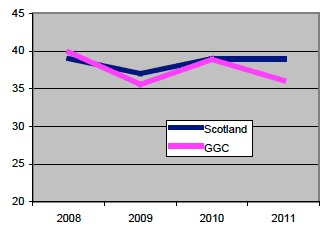
Source: Scottish Health Survey
There are gender differences. For men, compliance declines with age from 63% for 16-24 year olds to 11% for 75+. The largest gap between men and women is 22 percentage points for the 16-24 age group. The level of female participation stays broadly similar up to age 54, and then declines.
Area deprivation (according to SIMD) is significantly associated with the likelihood of meeting the physical activity recommendations. Women living in the most deprived two quintiles were least likely to have met the recommendations (29%) whilst adherence to the recommendations ranged from 35% to 36% among women in the three least deprived quintiles. There was a similar pattern for men, with those in the most deprived quintile being least likely to have complied with the recommendations (39%) whilst those in the two least deprived quintiles had a figure of 49%.
Table A.1: Proportion of adults meeting physical activity recommendations by age, sex and socio-demographic characteristics 2011
| Male | Female | All Adults | |
|---|---|---|---|
| Age | |||
| 16-24 | 63 | 41 | 52 |
| 25-34 | 61 | 45 | 53 |
| 35-44 | 54 | 42 | 48 |
| 45-54 | 48 | 38 | 43 |
| 55-64 | 32 | 27 | 30 |
| 65-74 | 23 | 18 | 20 |
| 75+ | 11 | 6 | 8 |
| SIMD quintile | |||
| 5th (least deprived) | 49 | 36 | 42 |
| 4th | 49 | 35 | 42 |
| 3rd | 47 | 35 | 41 |
| 2nd | 42 | 29 | 35 |
| 1st (most deprived) | 39 | 29 | 34 |
| Income quintile | |||
| 1st (highest) | 50 | 38 | 44 |
| 2nd | 49 | 36 | 43 |
| 3rd | 49 | 34 | 41 |
| 4th | 44 | 29 | 36 |
| 5th (lowest) | 35 | 27 | 31 |
Source: Scottish Health Survey
Household income is also associated with physical activity levels with a clear linear relationship with those on higher incomes being more likely to meet recommendations. There is a difference of 15 percentage points between the top and bottom quintiles of income for men and a difference of 10 percentage points between top and bottom quintiles of income for women, and these differences are statistically significant. Health Board breakdowns of key Scottish Health Survey indicators, including physical activity, have now been published on the website44. On 30 October, breakdowns by ethnicity, religion, sexuality and disability will be published in a topic report on equality groups.
A2: % of children participating in moderate exercise at recommended levels (Age 2-15)
Why is this indicator important? This is the parallel headline indicator to A1 for children. Let's Get Scotland More Active aims to raise the participation of children in the minimum recommended levels of activity (1 hour per day) to 80%.
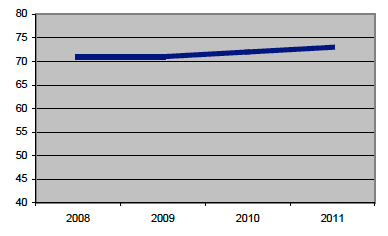
Source: Scottish Health Survey
What do the data tell us? The proportion of children meeting the recommendations has increased slightly (but not significantly) from 71% in 2008 to 73% in 2011. This includes school-based physical activity. In GGC this figure was 71% in 2010/2011 combined.
Excluding school-based activity gives a longer time series for Scotland, extending back to 1998 when 65% were meeting the recommended levels with non-school exercise. This hasn't changed significantly since then (with the exception of a peak of 69% in 2003). The level in 2011 was 65%, and was 63% in GGC during years 2010-2011 combined. These figures suggest that school-based activity pushes a reasonable amount over the margin into recommended levels of activity (though it will add extra activity to many other children already meeting the guidelines).
An age-range of 2-15 is, of course, a very diverse group, so it is worth exploring how well the recommendations are achieved during different ages in childhood. Focussing on the measure including school-based activity, ages 5-10 had peak levels in 2011 of 80%-81%, and ages 13-15 were the lowest with 59%. The gender gap opens up substantially at 13-15 years old, with 69% of 13-15 year-old males active at recommended levels compared to 48% of 13-15 year-old females. The fall in female activity levels between the ages of 11-12 and 13-15 is the main contributor of the fall in overall participation from its peak at age 8-10 although there is a significant reduction in male activity as well (from 82% at 8-10 to 69% at 13-15). In GGC there is a similar age pattern, although the peak in activity is more pronounced in the 8-10 age group (84%) and the drop off in 13-15 year olds is less severe (65% of 13-15 year olds in GGC met recommendations). With respect to area deprivation there was a significant association between SIMD and activity among boys, but not girls. However, the pattern was not linear: 81% of boys in the least deprived quintile, and 77% in the second most deprived quintile, met the recommendations, while for boys in the remaining three groups, the figure ranged from 72% - 74%. Looking at activity for both adults and children, it appears that the gender divide which is already present at age 16 opens up in the teenage years.
A3 : % of adults with low levels of physical activity
Why is this indicator important? Looking at levels of "low" physical activity (less than 30 minutes moderate or vigorous activity a week), we may get some insights into how far we have to go in order to get people meeting the recommendations.
What do the data tell us? Overall, 32% of adults in Scotland had low levels of physical activity in Scotland in 2011, with the same proportion seen in GGC.
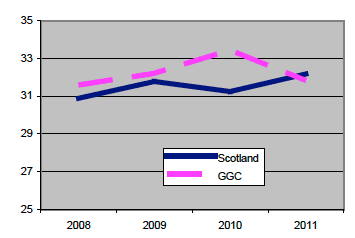
Source: Scottish Health Survey
At both Scotland and GGC levels there is, as might be expected, a pattern with age. Within Scotland there is also a significant difference in the proportion of men with low activity levels in the most (38%) and least-deprived (25%) quintile. The figures for women are 42% and 30% respectively. The differences are also significant for income with the top quintile showing 22% with "low" activity compared to 41% for the bottom quintile for men, and 27% and 45% for women.
The fact that these differences are substantial and significant suggests that there may be less people in deprived areas and lower income groups on the "margin" who can be relatively easily moved into the group achieving physical activity recommendations, so that efforts should be given to getting very inactive groups to start exercising in a small way.
A4: % of children with low levels of physical activity
Why is this indicator important? This indicator is the parallel indicator to A3 for children. Again, looking at levels of "low" physical activity (less than 30 mins a day), we may get some insights into how far we have to go in order to get people meeting the recommendations.
What do the data tell us? The trend since 2008 has decreased slightly (but not significantly) and the figure for 2011 stands at 10%. Again there is a gender pattern, with 8% of boys and 12% of girls with low levels of activity in 2011. Once, again it is clear that the biggest change takes place with teenage girls, in 2010/11 we see the proportion with low activity jumps from 8% for 8-12 year-olds to 22% for 13-15 year-olds. The gender difference is also evident in GGC, but the data does not allow us to separate by age due to small sample sizes.
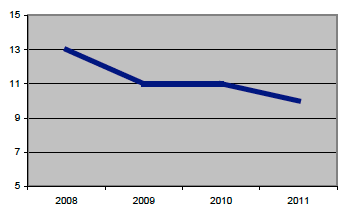
Source: Scottish Health Survey
A5: % of adult population participating in sport (excluding walking) in the last four weeks
Why is the indicator important? Sport is a key medium for physical activity. It provides an environment, structure and infrastructure within which people can be active. In addition, participation in sport can have a host of other impacts with respect to nurturing communities and longer-term success at elite levels.
What do the data tell us? Scottish Household Survey data suggest that participation in sport has remained fairly stable in the four years to 2010 and increased slightly in 2011 when 54% of adults participated in sport at least once in the previous four weeks. Of sports, swimming is the most common, with 18% participation followed by Keep fit/aerobics (14%) and multigym/weight training (12%). Football is the most common of the conventional "team" sports at 8%. In the City of Glasgow sport participation has followed a similar pattern to the Scottish figures and was 50% in 2011.
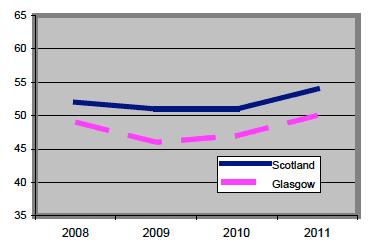
Source: Scottish Household Survey
Table 2 suggests similar patterns for sport participation to that for physical activity in general. There is a significant difference between genders, with 60% of men and 48% of women participating (although not as large as that for physical activity). There are significant differences for age groups (declining as respondents get older) and between the top and bottom of the deprivation scale.
Table A.2: Participation in Sport in the last four weeks (%) 2011
| Any Sport (excluding walking) | |
|---|---|
| All | 54 |
| Gender | |
| Male | 60 |
| Female | 48 |
| Age | |
| 16-24 | 75 |
| 25-34 | 69 |
| 35-44 | 64 |
| 45-54 | 53 |
| 55-64 | 41 |
| 65-74 | 35 |
| 75+ | 21 |
| SIMD quintile | |
| 1st (most deprived) | 44 |
| 2nd | 49 |
| 3rd | 52 |
| 4th | 58 |
| 5th (least deprived) | 64 |
Source: Scottish Household Survey
Frequency of participation is important to understand when considering sport's contribution to physical activity targets. Around 28% participated for 21 or more days in the previous 4 weeks, they are likely to be a substantial proportion of those who meet the physical activity targets (although we do not know how intense or prolonged their participation is). At the other end of the scale, around 24% only participated on 1-4 days in the previous four weeks, suggesting that sport may have a greater role to help individuals meet the activity recommendations (or that an alternative to sport must be found, e.g. if time is the most significant barrier to participation). Further work is underway in the Scottish Government to examine what the Scottish Health and Household Surveys tell us about the relationship between sport participation and physical activity.
A6: % of children participating in sport in the previous week
Why is the indicator important? This indicator parallels A5 for adults. However recruitment of young people into sporting participation may also have greater impacts at professional levels, and help build in a habit of health activity for later life.
What do the data tell us? Scottish Health Survey data suggest the proportion of children participating in sport in the previous week has been broadly stable since 1998 and was 69% in 2011. In GGC this figure was 73% for 2010/2011.
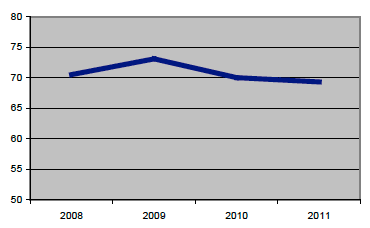
Source: Scottish Health Survey
A similar pattern to physical activity exists when considering participation by age. Broadly, participation rises during childhood, peaking at age 11-12 and then drops off thereafter, particularly sharply at the age of 13-15. This is the case for both males and females, but particularly so for girls, where there is a drop from 70% to 53% between the age bands 11-12 and 13-15. For boys the figures were 85% and 74% respectively. It is not possible to examine age and gender patterns for GGC due to small numbers. In contrast with physical activity, there is a significant association between sport participation and area deprivation for both boys and girls. The most deprived fifth of the population has participation levels of 58%, and the least deprived at 76%.
A7: Awareness of Physical Activity Recommendations (percentage of the population)
Why is the indicator important? While many are active without specific motivations to maintain or increase their health, for many people, an awareness of what they need to do to stay healthy may be a building block in helping them to be intentional about activity into their daily lives.
What do the data tell us? The numbers who are aware of the physical activity recommendations have increased slightly from 22% in 2008 and in 2010 stood at 26%. At the same time, the numbers underestimating the recommendations fell from 51% to 46%. The exact causality between awareness and fulfilling the recommendations is not clear. However the data suggest that those who were also exhibiting low levels of physical activity, were also less likely to correctly identify correctly the recommendations than those with higher levels of physical activity. Just 17% of the less active group correctly identified the recommendation in 2008/2009. In part this can be explained by the higher numbers of inactive older people, who are less aware of the recommendations.
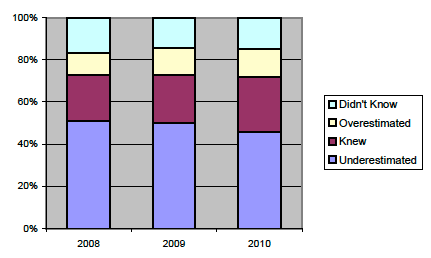
Source: Scottish Health Survey KAM module
The differences between social groups need care in interpretation. While there appears to be little difference between men and women, and between deprivation quintiles with respect to underestimating the recommendations, there is more spread with respect to actually identifying the recommendations correctly.
A8 Percentage of adults making one or more visits to the outdoors per week
Why is this indicator important? While people can visit the outdoors without physical activity being involved, for many the enjoyment of greenspace and Scotland's natural heritage will provide a pleasant environment in which to be active. There is some evidence that mental health is also more likely to be enhanced by activity outdoors rather than at home or in the gym45, 46 .
What do the data tell us? Figures from the Scottish Recreation Survey suggest that the vast majority of the population (83%) are involved in some sort of outdoor recreation, however just under half (46%) are doing this weekly. While not all of this may be physical activity, it does suggest the outdoors can play a key part in providing a setting for exercise, and not necessarily in organised sports.
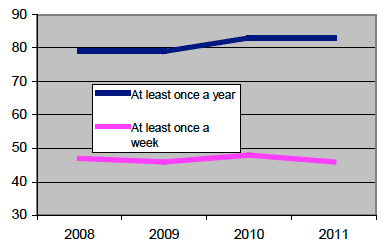
Source: Scottish Recreation Survey
There are limited breakdowns for the figures, but visits decrease with age (91% of under-35s and 71% of over-54s visit at least once a year) and occupational group (92% of the AB "managerial and professional" occupations and 73% of the DE "unskilled workers and unemployed").
A9 % of adults who have walked more than 30 minutes for recreation in the past four weeks
Why is this indicator important? Walking is the easiest form of physical activity to access. In this case, we measure intentional walking for recreation (rather than commuting which is contained in the Active Travel indicator below). This may be an entry-point to more sustained or vigorous physical activity, or it may simply be the appropriate way activity is integrated into a busy life.
What do the data tell us? There has been no significant change since 2008 and the figures stand at 57% for Scotland and 51% for Glasgow in 2011. A significant amount of these are not doing any other sport (recreational walking would increase the sport participation figure from 54% to 75%, so it is a key building block in participation in physical activity). There isn't a significant difference by gender (Male 56%, Female 58%) but by age there is a peak of 64% at ages 35-44, falling to 32% for those aged 75 and over.
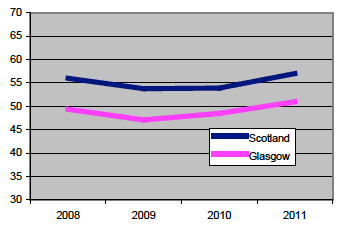
Source: Scottish Household Survey
However, while there might not be an explicit financial barrier to participation, there is a deprivation gradient with 47% of those in the most-deprived quintile walking recreationally, compared to 63% in the least-deprived quintile. It is likely that that the causes that drive this deprivation gradient are complex and deep-rooted.
A10: Active travel to work
Why is this indicator important With Let's Get Scotland More Active suggesting that lack of time is an issue about why people do not undertake exercise, the potential for devoting existing commuting time to an active mode of travel to work, particularly if the journey is relatively short, is an attractive prospect.
What do the data tell us? Travel to work using either walking to cycling has been broadly stable since the Scottish Household Survey series began in 2000, and now stands at 15%. The figure for Glasgow City is 16%.
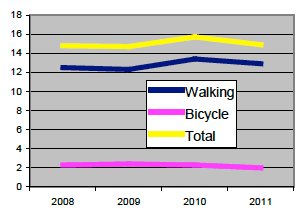
Source: Scottish Household Survey
Cycling is a relatively small part of the national figure at just 2%. The results are strongly socially patterned, with 18% of those with a household income under £10,000 walking to work, but 7% of those with an income in excess of £40,000. In addition women (16%) are more likely to walk than men (10%). 16-29 year olds are most likely to walk (19%) compared to 40-49 year olds (11%).
The Scottish Household Survey Travel Diary for 2009/10 suggests that travel by private car or taxi (44%) has a much greater share of journeys between 2 and 3 km than walking and cycling combined (17%), so there is potential for growth.
A11: Gross Value Added - sport and leisure £m
Please see flourishing annex (F1) for the information on the indicator and data from 2008 to 2011.
A12: Employment - sport and leisure
Please see flourishing annex (F3) for the information on the indicator and data from 2008 to 2011.
A13: Ultimate Sport Cities (ranking and score)
Why is this indicator important? The international rating of the City of Glasgow as a host city for sporting events will be important for Scotland's reputation. Certain aspects of the ranking can be extracted for sport and facilities impacts and these will be an external illustration of progress in those areas. We wish to make absolute improvements as well as improvements relative to other host cities, hence the inclusion of the score. The SportBusiness Ultimate Sports Cities Awards are internationally recognised rankings of the world's top sports hosts. These have been held every second year since 2006.
What do the data tell us? Glasgow moved up two places to number 9 in the world in 2012 with a score of 344. Glasgow also retained its position as the number in relation to sports marketing and branding. In 2010, Glasgow was ranked number 11 with a score of 291, and was also named number 1 for sports marketing and branding (data courtesy of SportBusiness www.sportbusiness.com/).
A14: Scottish Sporting Success
Why is this indicator important? The impact of elite sporting success, while it is not our intention to downplay wider population participation in sport or physical activity at all levels, represents an outcome that all Scots can enjoy and aspirations for Scotland's sports people can be encouraged and fulfilled. It also acts as an indicator internationally to illustrate the impact of sporting strategies on performance.
What do the data tell us? Discussions are underway about how best to measure sporting success. These data will become available in 2014.
Conclusions
Key indicators for physical activity, such as active travel, visits to the outdoors, sport participation and sport-related volunteering have been broadly stable since 2008. The trends for physical activity have been broadly positive since 1998, although they have been fairly stable since 2008.
There are social patterns, with lower participation for women and older age groups. It is clear that the gender gap opens up when children enter the teenage years, when there is a significant fall in participation, which is most marked for young girls. This is reflected in the supporting indicators for very low levels of activity (which are higher for teenage girls) and sport participation.
There is significant variation in participation in physical activity by deprivation, with those in the most deprived areas significantly less likely to meet the recommendations than those in the least deprived areas. For income there is a linear and significant relationship between rising income and participation in physical activity. Furthermore, underlying data for lower-level physical activity and sport participation suggest that there is even greater social patterning.
Contact
Email: Imelda Giarchi
There is a problem
Thanks for your feedback